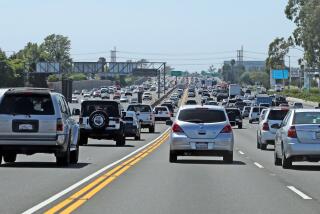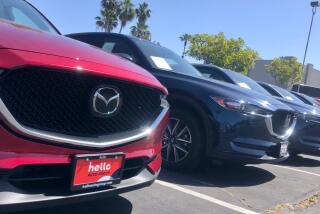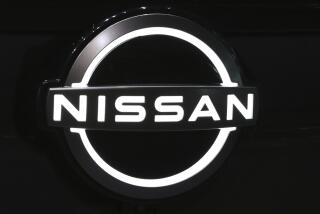Regulators Will Require Warning Labels in Autos With Air Bags
WASHINGTON — Federal highway safety regulators said Friday that they will require auto makers to put warning labels in cars with safety air bags, alerting owners to the potential danger to children and small adults.
Officials also unveiled a proposal to allow auto makers to reduce, by 25% to 30%, the force at which air bags deploy. The National Highway Traffic Safety Administration will accept comments on the plan for 30 days before making a final decision.
Agency officials also said they are working to finalize a rule that would allow car dealers and mechanics to disable air bags if car owners request it. That proposal will also be subject to 30 days of public comments.
The government has been under pressure to change federal standards for air bags, which have been blamed for the deaths of 31 children and 19 adults. The bags inflate at speeds as high as 200 mph and pose a particular risk to children and small adults, who take the impact in the head rather than the chest.
“Here’s the bottom line: Air bags enhance safety [in a car crash], but they must be improved,” said Ricardo Martinez, head of the NHTSA.
“There is no single solution,” he told a news conference, outlining the steps to allay the public’s concerns about air bag safety. “It’s a comprehensive strategy.”
The strategy also includes a required phase-in of the next generation of “smart” technology air bags by the 1999 model year.
The agency believes sophisticated air bag systems that are able to sense the position or weight of the passenger and adjust deployment to provide the best protection are the best long-term solution, and they are pushing manufacturers to develop them quickly.
But for now, the agency has ordered the brighter labels and has extended the time auto makers can install cutoff switches for passenger air bags in vehicles with no rear seat until Dec. 1, 2000.
Ford has the cutoff switch on the dashboard of its newer Ranger and F150 pickup trucks. And GM will soon install the switches in its new pickups.
Questioned by reporters Friday, representatives of Ford Motor Co., General Motors Corp. and Chrysler Corp. all said they did not know what the different proposals would cost. “We’ll figure out how to manage the cost,” said Bob Lange, GM’s director of vehicle development methodology and labs.
Air bag manufacturers include TRW Inc., Morton International Inc. and the Takata Corp.
Helen Petrauskas, Ford Motor Co.’s vice president for safety engineering, said the company will move as quickly as possible to de-power air bags and to develop “smart” bags.
Jason Vines, a spokesman for Chrysler Corp., said the company could have the lower-power air bags in its new cars and trucks by the end of 1997.
NEC Automotive Electronics is already developing the type of sensing technology that would be needed for the next generation of “smart” bags. NEC’s system can differentiate between a child or an adult and can even tell the difference between a front-facing child seat and a rear-facing child seat based on the difference in weight distribution on the car seat.
Phil Rittmueller, NEC’s vice president of automotive electronics, said NEC’s sensor system, which is based on electric field technology, would cost auto makers less than $40 per car. Rittmueller said that does not include the cost of labor required to install the sensors.
Rittmueller said that if auto makers worked with the component makers on the research and development, it is entirely conceivable that the smart systems could be available by the 1999 vehicle model year. Rittmueller said his company already makes the crash sensors that trigger the air bags in many vehicles. “We have a lot of expertise in the area of automotive safety sensors,” he said.
Lange, though, said he thought the 1999 target date for the next generation of smart air bags would be a stretch for GM.
“It’s not there because it’s not ready,” Lange said.
The NHTSA is proposing the other steps and will seek public comment before making a final ruling.
(BEGIN TEXT OF INFOBOX / INFOGRAPHIC)
Proposed Safety Measures
Main points of the National Highway Traffic Safety Administration’s five-part proposal on air bags:
LABELS:
Five yellow, red and black warning labels on both sides of visors, and a removable label on dashboard. To be required within three months.
Labels on child safety seats warning that air bags can kill children, the that safest place for them is in the back seat, and that a rear-facing child seat should never be placed in the front seat. To be required within six months.
DISCONNECTING AIR BAGS:
Consumers could have air bags disconnected once they are informed about the bags’ benefits. Law now bars garages and dealerships from disconnecting air bags on request. New policy by the end of the year.
LESS FORCEFUL AIR BAGS:
Air bags in new cars may deploy with less-explosive force. Government seeking public comment on which of two test changes to use so air bags will deploy with 20% to 35% less force. Officials want less-forcful bags installed within a year.
MORE SOPHISTICATED TECHNOLOGY:
Require auto makers to start phasing in next generation of “smart” air bags with the 1999 model year. Such systems sense position or weight of passengers and adjust air bag deployment for maximum protection.
CUTOFF SWITCHES:
Extend until late 2000 the period auto makers can install cutoff switches in vehicles with no rear seat. Last year, government began allowing passenger-side cutoff switches in trucks and cars without a rear seat. It chose not to extend cutoff switches to all vehicles.
* Source: Associated Press.






